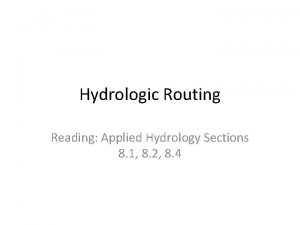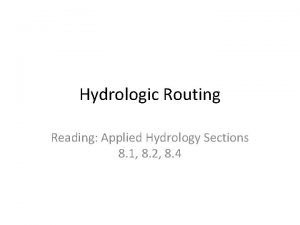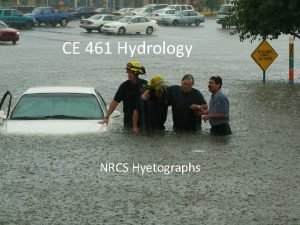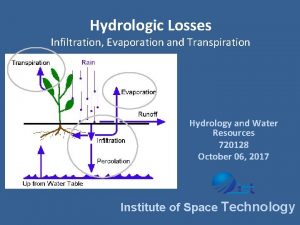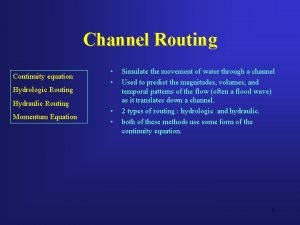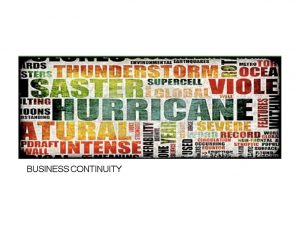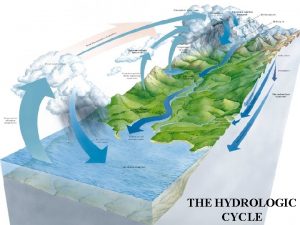Hydrologic River Routing Hydrologic Routing uses the continuity










- Slides: 10

Hydrologic River Routing • Hydrologic Routing uses the continuity equation to relate inflows, outflows and storage to solve for outflows – Simpler, more empirical, parameters estimated at application scale from experience and data • Hydraulic Routing uses continuity and momentum to solve open channel flow equations – More complex, while elegant mathematically, often requires information on flow geometry that is difficult to obtain or not available • We will only cover Hydrologic Routing (Hydraulic routing part of Hydraulics – open channel flow)

Hydrologic River Routing Applications 1. Given K, X and I(t), solve Q(t) 2. Given I(t), Q(t) infer K and X

Example 9. 3. 2 • Route the following inflow hydrograph using X=0. 2, K=0. 7 hr Time (hr) 0 1 2 3 4 5 6 7 Inflow (cfs) 0 800 2000 4200 5200 4400 3200 2500 Time (hr) 8 9 10 11 12 13 Inflow (cfs) 2000 1500 1000 700 400 0

Example 9. 3. 1 • Determine K, X from data Day Inflow Outflow (ft 3/s) 0. 5 2200 2000 1 14500 7000 1. 5 28400 11700 2 31800 16500 2. 5 29700 24000 3 25300 29100 3. 5 20400 28400 4 16300 23800 4. 5 12600 19400 5 9300 15300 5. 5 6700 11200 6 5000 8200 6. 5 4100 6400 7 3600 5200 7. 5 2400 4600

Hydrologic Simulation Models Learning Objectives • Use hydrologic simulation models to expedite hydrologic calculations • Determine the appropriate parameters for input to models depending on the setting and problem being addressed • Prepare the input to a hydrologic model (HEC HMS) for solution of hydrologic design problems • Run the model and interpret the output of hydrologic models for application in design

What Are Hydrologic Models used for? • to evaluate the response sensitivity of an input action in the context of design or solving a problem (Engineering) • to encode and encapsulate knowledge and test hypotheses (Science/Research) • to organize and structure the examination of available data and information focused on the problem at hand • to formalize communication across disciplines (solving problems involving multiple disciplines)

HEC HMS • http: //www. hec. usace. army. mil/software/hec-hms/

Example Subbasin Tc (hr) R (hr) CN Area (mi 2) 1 2. 5 5. 5 66 2. 5 2 2. 8 7. 5 58 2. 7 58 3. 3 3 Suppose that a development is proposed that changes land use and the CN in subbasin 3 from 58 to 70, what is the impact on the hydrograph? Can a detention basin be placed below junction to reduce peak to pre-development levels? How big should it be?

Components of an HEC-HMS Model • Basin Model – Basin • Subbasin, Reach, Reservoir, Junction, Diversion, Source, Sink • Meteorologic Model – Specified hyetograph, gage weights, frequency storm, gridded precipitation, inverse distance, SCS storm • Control Specifications – Start, end, time interval • Time series data – Precip, discharge, stage, temperature, solar radiation, wind speed, humidity, air pressure • Paired data – Storage-discharge, elevation-area, elevation-storage, elevationdischarge, inflow-diversion, diameter-percentage, cross-sections, unit hydrograph

Example 8. 3. 1 in HEC HMS The 1 - hr unit hydrograph for a watershed is given below. Determine the runoff from this watershed for the storm pattern given. The abstractions have a constant rate of 0. 3 in/ h. Time ( hr) Precipitation ( in) Unit hydrograph ( cfs) 1 0. 5 10 2 1 100 3 1. 5 200 4 0. 5 150 5 6 100 50
 Hydrologic routing and hydraulic routing
Hydrologic routing and hydraulic routing Hydrologic continuity equation
Hydrologic continuity equation Reservoir and channel routing
Reservoir and channel routing Hydrologic routing
Hydrologic routing Lumped flow routing
Lumped flow routing Absolute continuity implies uniform continuity
Absolute continuity implies uniform continuity Mark tinka
Mark tinka Difference between clock routing and power routing
Difference between clock routing and power routing Rickley hydrologic
Rickley hydrologic Hydrologic losses
Hydrologic losses Hydrologic engineering center
Hydrologic engineering center



